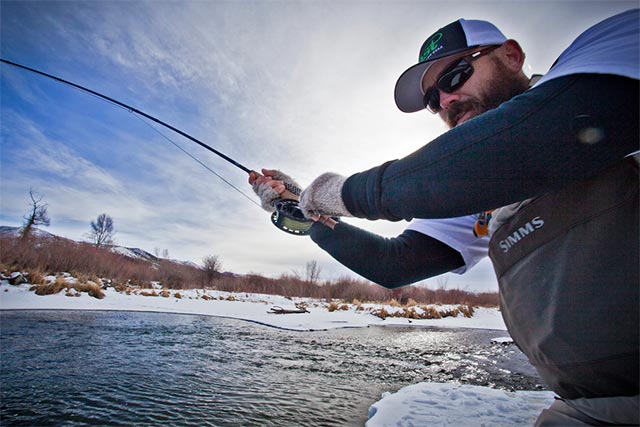Swimphing 101
It used to be a steelheader had to choose between artistry and soul—a.k.a., the swing—and their desire to catch every fish in the river—a.k.a., indy nymphing, chuck & ducking, and so on and so forth. Today we bring you a hybrid creature, a slippery customer. It’s a little bit country, a little bit rock and roll.
Today we bring the swimph.

Matt Guymon photo
That word—swimphing—has been used a few times over the years to describe a number of different approaches, all slightly different from what we’ll talk about today. For our purposes, swimphing refers to a presentation method that allows you to change instantly from swinging to indicator nymphing, and do both with tremendous amounts of line control. This system, developed by Michigan spey maven Barny Wong, is for that angler who loves to swing but hates the idea of bypassing fish out of presentation range of a swung fly due to irregular bottom contours such as a shale ledge, steep slot or logjam. It’s by no means a pure or particularly elegant approach as much as it is a guerilla tactic. If that sounds like something you can sink your teeth into, read on.
Rigging-wise, we begin with a switch rod overlined by at least two line weights with a long-bellied floating line as Scientific Anglers’ Steelhead taper, Rio’s Steelhead/Atlantic Salmon taper, or your preferred double taper in the appropriate line weight. To this you’ll attach a simple 9-foot tapered leader—whatever you typically use for indicator nymphing. Key to this step is sliding two thin bits of silicone tubing to the butt section of the leader before connecting to your fly line. These bits of tubing will be used to attach and detach your choice of “loose” floats, such as Raven Balsa floats. In the leader’s mid-section and tippet apply your choice of shot or tungsten, not in a clumped bunch but at regular intervals. This will allow the leader to sink more uniformly (like a sink tip), thus making for easier spey casting.
 It will take a few casts to get your stroke and timing down—it won’t cast exactly like your Skagit or Scandi head and sink tip—but with a few adjustments you should be able to deliver your payload a fair ways with accuracy. And once you get your casting down you are poised to effectively fish every inch of water before you. It’s simply a matter of picking your target, casting beyond and above it and then using a combination of stack mends and swinging under tension to steer your fly into position. When your fly comes up on your slot, trough or hole, simply drop the rod tip to let the rig fall into the hole for a short, tight, controlled plummet and swing. No takers on the swing? Simply affix your float for a few dead-drifts along the seams. That float can also be used to suspend a swung fly in particularly shallow water or to get over a logjam to the prime water behind it.
It will take a few casts to get your stroke and timing down—it won’t cast exactly like your Skagit or Scandi head and sink tip—but with a few adjustments you should be able to deliver your payload a fair ways with accuracy. And once you get your casting down you are poised to effectively fish every inch of water before you. It’s simply a matter of picking your target, casting beyond and above it and then using a combination of stack mends and swinging under tension to steer your fly into position. When your fly comes up on your slot, trough or hole, simply drop the rod tip to let the rig fall into the hole for a short, tight, controlled plummet and swing. No takers on the swing? Simply affix your float for a few dead-drifts along the seams. That float can also be used to suspend a swung fly in particularly shallow water or to get over a logjam to the prime water behind it.
Fly-wise, this is no country for Intruders (obviously). It’s a system best fished with hybridized nymphs and streamers. Like to swing sculpins? Downsize one or two hook sizes and deploy some synthetics for a slightly sparser tie—they’ll drop more nymphly through the water column. If you like to indy-fish stones and hex nymphs, try adding some rubber and articulation to your patterns, and up your hooks a size.
As I hope I’ve been able to demonstrate, swimphing is not a compromise so much as a weapon or tool. It’s like being a switch hitter: depending on the situation, you can swing or nymph. Or both. This is a great system for presentation omnivores who don’t want to bring two rods—or just can’t.
January and February is a great time to try new things on the water. Populations of savvy winter fish are being complemented slowly and surely by spring run fish. Pressure remains low. Bigger nymphs are starting to get active, with the bug bite slowly overtaking the egg bite by mid-February. A good mix of fish in the river, plenty of wiggly food drifting by and no one to rush you through your beat—sounds like a good time to fish every inch of water, be it swinging or nymphing or something in between.











